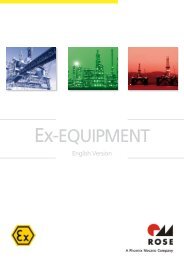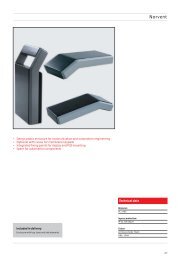STAINLESS STEEL ENCLOSURES - Rose Systemtechnik GmbH
STAINLESS STEEL ENCLOSURES - Rose Systemtechnik GmbH
STAINLESS STEEL ENCLOSURES - Rose Systemtechnik GmbH
You also want an ePaper? Increase the reach of your titles
YUMPU automatically turns print PDFs into web optimized ePapers that Google loves.
Chemical resistance<br />
When deciding whether an enclosure is resistant to the effects of chemical substances, you must<br />
consider both the enclosure material and the type of seals.<br />
The table below shows the most important basic materials used in ROSE enclosures and the most<br />
frequently encountered chemical substances. This table provides information only on the extent<br />
to which materials are essentially resistant to certain chemicals. However, you must also take into<br />
account the concentrations and ambient temperatures.<br />
In cases where several chemicals occur together, we recommend that you carry out a precise investigation<br />
in order to evaluate the chemical resistance of a particular material.<br />
Chemical resistance of enclosure materials and seals<br />
The investigations, unless stated otherwise, were carried out at room temperature. Resistances can<br />
vary when two different materials come into contact with one another. We cannot therefore accept<br />
liability for this data.<br />
Explanation of symbols<br />
+ resistant against all concentrations<br />
+ resistant against maximum % concentration<br />
C° resistant to maximum C°<br />
• limited resistance<br />
- not resistant<br />
/ no information<br />
General technical information<br />
Chemicals Stainless steel EPDM Polyurethane Silicone<br />
Acetone + + - •<br />
Formic acid + / / •<br />
Ammonia + • / +<br />
Petrol + / + +<br />
Benzene + • + -<br />
Brake fluid / up to 150°C / +<br />
Butane / / / -<br />
Butanol / + / -<br />
Calcium chloride + • / /<br />
Chloral benzene / / - -<br />
Diesel oil / / + •<br />
Acetic acid + + / -<br />
Formaldehyde + up to 30% / +<br />
Freon 113 / / / /<br />
Fruit juice + + + +<br />
Glycerine + + + +<br />
Fuel oil + / + •<br />
Hydraulic oil / • / •<br />
Caustic potash solution + • / /<br />
Potassium chloride + • + +<br />
Potassium hydroxide + • - •<br />
Linseed oil + / + •<br />
Methane + + / +<br />
Methylene chloride + / - -<br />
Lactic acid + • / /<br />
Mineral oils / / + +<br />
Motor oils / / + +<br />
Sodium carbonate + • / /<br />
Sodium chloride • • + +<br />
Sodium hydroxide + • - •<br />
Soda lye + • / -<br />
Nitric acid + up to 10% - -<br />
Hydrochloric acid + up to 10% - /<br />
Lubricating oil + / + +<br />
Carbon bisulphide + / / -<br />
Sulphuric acid + / / 25 %<br />
Suds + • • +<br />
Cleansing agent + / • +<br />
Terpentine oil / / / -<br />
Carbon tetrachloride / / - -<br />
Toluene / / - -<br />
Trichlorethylene / / - -<br />
Water (dest. Water,<br />
river-, mains-, sea)<br />
+ + + +<br />
Tartaric acid / • + +<br />
Xylene / / - -<br />
Zinc sulphate / • / +<br />
Citric acid / • / +<br />
41








